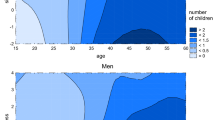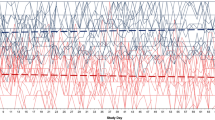Abstract
Married men in Germany (n=48) and America (n=50) between 50 and 80 years old, none in poor health, provided comparable information on sexual behavior and attitudes, and gave saliva samples from which testosterone was assayed. Sexuality declines with age, as expected. Neither testosterone nor psychological depression explain levels of sexuality. In both nations, wife's desire for intercourse, subject's ability to maintain an erection, and subject's imagination about other women, explain certain aspects of sexuality. Subject's health and marital satisfaction are related to sexuality among Americans but not among Germans. Behavioral models for the two nations are compared.
This is a preview of subscription content, access via your institution
Access options
Subscribe to this journal
Receive 8 print issues and online access
$259.00 per year
only $32.38 per issue
Buy this article
- Purchase on Springer Link
- Instant access to full article PDF
Prices may be subject to local taxes which are calculated during checkout


Similar content being viewed by others
References
Michael R, Gagnon J, Laumann E, Kolata G. . Sex in America Warner Books: NY 1994
McKinlay J, Feldman H. . Age-related variation in sexual activity and interest in normal men; results from the Massachusetts male aging study. In: Rossi A (ed). Sexuality Across the Life Course. University of Chicago: Chicago 1994 261–285.
Laumann E, Paik A, Rosen R. . Sexual dysfunction in the United States. JAMA 1999 281: 537–544.
McKinlay J, Longcope C, Gray A. . The questionable physiologic and epidemiologic basis for a male climacteric syndrome. Maturitas 1989 11: 103–115.
Krause W. . Do we need the concept of male climacteric? Fortschritte der Medizin 1995 113: 32–40.
Mazur A. . Aging and endocrinology. Science 1998 279: 305–306.
Couillard C et al . Contribution of body fatness and adipose tissue distribution to the age variation in plasma steriod hormone concentrations in men. J Clin Endoc Met 2000 85: 1026–1031.
Tsitouras P, Martin C, Harman S. . Relationship of serum testosterone to sexual activity in healthy elderly men. J Gerontology 1982 37: 288–293.
Davidson J et al . Hormonal changes and sexual function in aging men. J Clin Endoc Met 1983 57: 71–77.
Sadowsky M, Antonovsky H, Maoz B. . Sexual activity and sex hormone levels in aging men. Intern Psychogeriatrics 1993 5: 181–186.
Mazur A, Booth A. . Testosterone and dominance in men. Behav Brain Sci 1998 21: 353–363.
Feldman H et al . Impotence and its medical and psychosocial correlates. J Urology 1994 151: 54–61.
McKinlay J. . The worldwide prevalence and epidemiology of erectile dysfunction. Int J Impot Res 2000 12: Suppl 4 S6–S11.
Edwards J, Booth A. . Sexuality, marriage, and well-being; the middle years. In: Rossi A (ed). Sexuality Across the Life Course. University of Chicago: Chicago 1994 233–259.
Araujo A et al . The relationship between depressive symptoms and male erectile dysfunction. Psych Med 1998 60: 458–465.
Dabbs J et al . Reliability of salivary testosterone measurements. Enzymes Protein Markers 1995 41: 1581–1584.
Granger D, Schwartz E, Booth A, Arentz M. . Salivary testosterone determination in studies of child health and development. Horm Beh 1999 35: 8–27.
Mazur A. . Biosocial models of deviant behavior among male army veterans. Biol Psy 1995 41: 271–293.
Radloff L. . The CES-D scale; a self-report depression scale for research in the general population. Applied Psych Meas 1977 1: 385–401.
Kaplan H. . The Evaluation of Sexual Disorders Brunner/Mazel: NY 1983
Acknowledgements
We appreciate the contributions and advice of Allan Birnbaum, Sam Feld, Douglas Granger, John McKinlay, Rolf Porst, Sanford Temes, and Douglas Wolf. This work was supported by Grant No. P20-AG-12837 from the US National Institute of Aging, and Grant No. 01EUK9910/063-99 from the German Federal Ministry of Education and Research.
Author information
Authors and Affiliations
Corresponding author
Rights and permissions
About this article
Cite this article
Mazur, A., Mueller, U., Krause, W. et al. Causes of sexual decline in aging married men: Germany and America. Int J Impot Res 14, 101–106 (2002). https://doi.org/10.1038/sj.ijir.3900833
Received:
Accepted:
Published:
Issue Date:
DOI: https://doi.org/10.1038/sj.ijir.3900833
Keywords
This article is cited by
-
Views of family physicians on heterosexual sexual function in older adults
BMC Family Practice (2018)
-
Average Associations Between Sexual Desire, Testosterone, and Stress in Women and Men Over Time
Archives of Sexual Behavior (2018)
-
Gender Differences and Similarities in Sexual Desire
Current Sexual Health Reports (2014)
-
Testosterone and Sexual Desire in Healthy Women and Men
Archives of Sexual Behavior (2012)
-
The effect of DA-8159, a novel PDE5 inhibitor, on erectile function in the rat model of hypercholesterolemic erectile dysfunction
International Journal of Impotence Research (2005)



